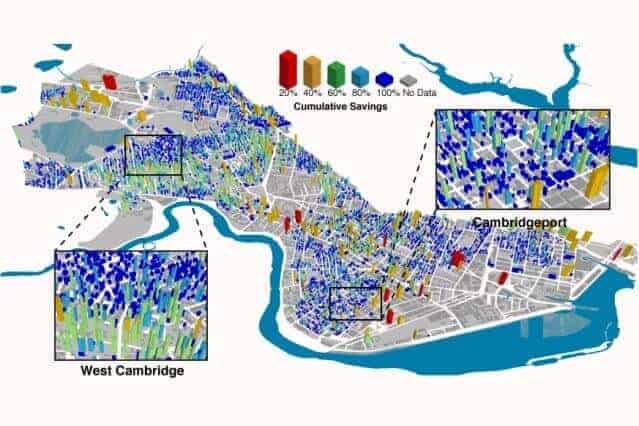Many programs encourage owners of homes and other buildings to improve their energy efficiency, sometimes offering substantial subsidies or tax incentives for doing so. Now, planners may have a way to determine where such programs can get the most return for that investment: New research shows how to identify the buildings where retrofitting for energy efficiency will have the biggest impact on a city’s overall greenhouse gas emissions.
The new findings, which require only minimal information about the buildings and their energy use, was developed by Marta González and Franz-Josef Ulm, MIT professors of civil and environmental engineering; Mohammad Javad Abdolhosseini Qomi PhD ’15, who was graduate student when the research was conducted; and five others at MIT and other institutions. The results are being reported in the journal Interface, published by the Royal Society in the U.K.
The authors point out that 44 percent of all energy used in buildings in the United States goes toward heating and cooling, and this accounts for 20 percent of the nation’s carbon dioxide emissions. So, making a significant dent in that sector could help the country meet its commitments for curbing greenhouse gas emissions.
But not all housing is created equal, and making retrofits in some of the least efficient buildings could have a much bigger impact on emissions than fixing up buildings that already perform relatively well. Figuring out how to identify the buildings most in need of improvement, however, at a scale useful for city officials and utility companies, is not a simple task.
González explains that there are 82 different parameters that can have an effect on the overall thermal efficiency of a building, but much of these data require detailed on-site measurement and in some cases specialized equipment, making it impractical to do such assessments at the scale of entire cities. But after a careful study of representative areas in Boston and Cambridge, Massachusetts, the team found that it is possible to use just eight of these factors to reach conclusions that are almost as accurate, which makes the task much more feasible.
“My work is about reducing the number of variables you need to know,” González says. “Is there a way to do urban planning without knowing all the details?” And in this case, she and the team found, there is indeed. The factors they isolated, she says, “are the variables that matter. You can really concentrate on those eight.”
In fact, Ulm says, just three of the factors alone can account for 85 to 90 percent of the variability between buildings, making it much easier to perform at least a first-order evaluation of a city’s housing stock.
The key to making useful assessments turned out to be a direct measure of people’s energy use during cold months: their monthly gas bills. By comparing anonymized bill information from the gas company with city-provided data on the size and volume of the buildings, and with weather data showing the outside temperatures during the study period, the team found they could make detailed predictions about which buildings would benefit the most from the retrofits, which include such steps as adding insulation, sealing leaky windows and doors, and replacing older single-pane windows with newer double-pane versions.
The analysis showed that selecting just 16 percent of the buildings in Cambridge for such retrofits, based on the formula they developed, would be enough to eliminate 40 percent of the city’s natural gas usage. “We had no idea that helping out a few could make such a difference,” Ulm says.
“The city has incentives to reduce its carbon footprint,” he says, since Cambridge, like many cities, has committed itself to becoming carbon-neutral. This research, he says, is a way for MIT “to give back to the community and the city,” by offering them a way to maximize the impact of dollars spent on reducing energy consumption. “There must be some policies that go beyond just price,” he says, to include specific criteria for selection, and the formula devised from this research could provide a solid rational basis for such targeted policies.
Perhaps surprisingly, the team found that residents’ choices about the temperature settings of their individual thermostats was not a major factor in the selection, and that useful information could be gleaned from the data without such building-specific information. “The variability is relatively small” based on people’s temperature preferences, Ulm says.
The team confirmed their findings by looking at detailed information on a subset of more than 6,000 buildings in Cambridge. One next step, they say, will be to compare outcomes if and when some of those buildings do receive these energy retrofits.
In simulations, the researchers showed that adopting a strategy based on their formula would have a greater impact than programs that, like most energy-retrofit incentives currently, are essentially random, such as tax incentives that are offered to anyone who meets basic criteria, regardless of the specific conditions of their buildings.
This new analysis, Ulm says, could make it possible for cities to adopt “very targeted strategies” for reducing energy use for heating and cooling. The team’s methodology, he says, could enable city officials “to develop the fastest path to energy efficiency, at a city scale.” One remaining step in the research, he says, is to look at lifecycle cost analysis. “Let’s see the return on investment,” he says, “to see if one were to add in the dollar price per kilowatt-hour of energy reduction, how would that change the choices, at the city scale?”
The research was supported in part by grants from the MIT-Accenture Alliance in Business Analytics, the Center for Complex Engineering Systems, and the National Science Foundation. It was sponsored by the Concrete Sustainability Hub, supported by the Portland Cement Association and the Ready Mixed Concrete Research and Education Foundation.


